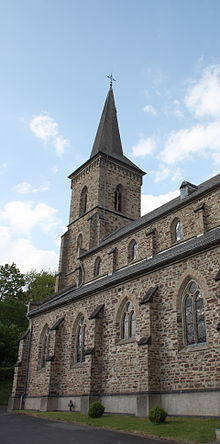Hermann Nebel
Hermann Nebel (born July 31, 1816 in Koblenz ; † July 23, 1893 there ) was an architect who worked on the Middle Rhine and Moselle and had been a city architect in Koblenz since 1848. In particular, he made pumice known as a building material.
He was the son of the government building inspector and architect Ferdinand Nebel (1783-1860). After he had been elected municipal master builder in Koblenz on December 20, 1848, he made attempts in particular to form building blocks by mixing pumice sand with water and lime. Pumice is available in large quantities in the Koblenz-Neuwied basin. His attempts were successful and the process he developed was soon used by hundreds of companies. In addition to his architectural work, the promotion of the stone industry in the area around Koblenz that he initiated is particularly noteworthy.
buildings
Numerous secular and sacred buildings are known, including:
- 1847–1849: Villa Deinhard on the Winning estate in Deidesheim
- 1849–1850: Reconstruction and expansion of the Ketschauer Hof (today Bassermann-Jordan winery ) in Deidesheim
- 1849–1852: Catholic parish church St. Stephanus and Georg in Polch
- 1851–1852: Catholic parish church of St. Remigius in Wassenach
- 1852: Catholic Church of St. Martin in Winningen
- 1854–1856: St. Markus Chapel in Minkelfeld
- 1854–1862: Catholic parish church of St. Remigius in Retterath
- 1856: Rectory in Wanderath
- 1855–1857: Synagogue in Vallendar (east facade preserved)
- 1859–1863: Catholic Church of St. Simon and Juda in Büchel (except for the tower torn down in 1957)
- 1859: Town hall in Polch
- 1860–1861: Tower of the Catholic parish church St. Maximin in Ettringen
- 1860: Nave and tower of the Catholic parish church St. Katharina in Isenburg
- 1860–1862: St. Wendelin's Catholic Church in Kliding
- 1861: Parish house of St. Pankratius in Niederberg
- 1861–1862: Castle chapel of Sayn Castle
- 1862–1872: Catholic parish church of St. Kastor in Kehrig
- 1862: Catholic Church of St. Giles in Roes
- 1864–1869: Catholic parish church St. Medardus in Bendorf
- 1865: Club house of the Catholic reading club, called "Görreshaus", in Koblenz (attributed)
- 1865–1869: West tower of the Catholic parish church St. Peter in Westum (town of Sinzig )
- 1865–1866: Catholic Church of St. Silvester in Brenk
- 1867–1877: Synagogue in Polch
- 1868–1870: Catholic parish church St. Rochus in Hatzenport
- 1868–1872: Catholic parish church St. Stephan in Nachtsheim (demolished 1968)
- 1868: Former furnace factory of the Moravian Brethren Neuwied , Friedrichstrasse / corner of Langendorfer Strasse
- 1869–1872: Former boys' institution of the Moravian Brethren in Neuwied, Friedrichstrasse
- 1870: former elementary school Hatzenport, Moselstr. 8th
- 1870–1875: Transept and choir of the Catholic parish church of St. Lambert and Katharina in Niederlützingen ( Burgbrohl municipality )
- 1870–1875: Catholic parish church of St. Remaclus in Waldorf
- 1871–1876: Transept and choir of the Catholic parish church of St. Bonifatius in Großmaischeid
- 1873: St. Kastor elementary school in Koblenz (destroyed in the war)
- 1877: formerly higher private school Bendorf, Engerser Str. 35
- 1880–1882: Catholic parish church of St. Johannes Apostel in Gondorf
- 1885: Synagogue in Münstermaifeld (attribution assumed)
literature
- Julia Benthien: The Koblenz city architect Hermann Nebel (1816–1893). Life and work. (Diss. Cologne 2005). Cologne Architecture Studies 83rd Cologne 2006. with numerous illus.
Web links
- Entry on Hermann Nebel in the Rhineland-Palatinate personal database
| personal data | |
|---|---|
| SURNAME | Nebel, Hermann |
| BRIEF DESCRIPTION | German architect and master builder in Koblenz |
| DATE OF BIRTH | July 31, 1816 |
| PLACE OF BIRTH | Koblenz |
| DATE OF DEATH | July 23, 1893 |
| Place of death | Koblenz |



